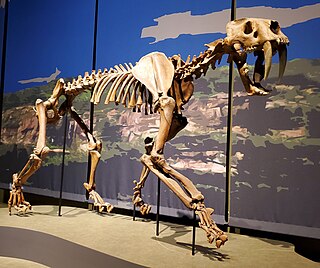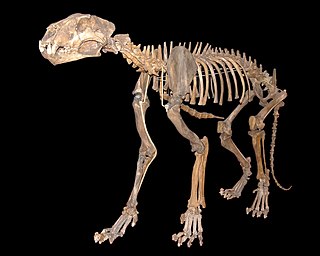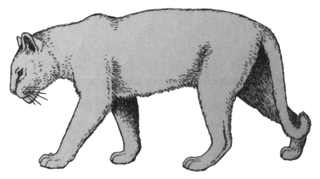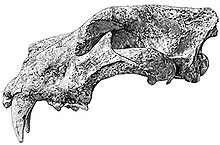
Felidae is the family of mammals in the order Carnivora colloquially referred to as cats. A member of this family is also called a felid. The term "cat" refers both to felids in general and specifically to the domestic cat.

The lion is a large cat of the genus Panthera, native to Africa and India. It has a muscular, broad-chested body; a short, rounded head; round ears; and a hairy tuft at the end of its tail. It is sexually dimorphic; adult male lions are larger than females and have a prominent mane. It is a social species, forming groups called prides. A lion's pride consists of a few adult males, related females, and cubs. Groups of female lions usually hunt together, preying mostly on large ungulates. The lion is an apex and keystone predator; although some lions scavenge when opportunities occur and have been known to hunt humans, lions typically do not actively seek out and prey on humans.

The leopard is one of the five extant species in the genus Panthera. It has a pale yellowish to dark golden fur with dark spots grouped in rosettes. Its body is slender and muscular reaching a length of 92–183 cm (36–72 in) with a 66–102 cm (26–40 in) long tail and a shoulder height of 60–70 cm (24–28 in). Males typically weigh 30.9–72 kg (68–159 lb), and females 20.5–43 kg (45–95 lb).
Panthera is a genus within the family Felidae, it is one of two extant genera in the subfamily Pantherinae, and contains the largest living members of the cat family. There are 5 living species, the tiger, jaguar, lion, leopard and snow leopard and a number of extinct species.

Smilodon is a genus of felids belonging to the extinct subfamily Machairodontinae. It is one of the best known saber-toothed predators and prehistoric mammals. Although commonly known as the saber-toothed tiger, it was not closely related to the tiger or other modern cats. Smilodon lived in the Americas during the Pleistocene epoch. The genus was named in 1842 based on fossils from Brazil; the generic name means "scalpel" or "two-edged knife" combined with "tooth". Three species are recognized today: S. gracilis, S. fatalis, and S. populator. The two latter species were probably descended from S. gracilis, which itself probably evolved from Megantereon. The hundreds of specimens obtained from the La Brea Tar Pits in Los Angeles constitute the largest collection of Smilodon fossils.

Homotherium is an extinct genus of machairodontine scimitar-toothed cat that inhabited North America, South America, Eurasia, and Africa during the Pliocene and Pleistocene epochs from around 4 million to 12,000 years ago. In comparison to Smilodon, the canines of Homotherium were shorter, and it was probably adapted to running down rather than ambushing prey.

Panthera spelaea, also known as the cave lion or steppe lion, is an extinct Panthera species that most likely evolved in Europe after the third Cromerian interglacial stage, less than 600,000 years ago. Genetic analysis of ancient DNA has revealed that while closely related, it was a distinct species genetically isolated from the modern lion occurring in Africa and Asia, with the genetic divergence between the two species variously estimated between 1.9 million and 600,000 years ago. It is closely related and probably ancestral to the American lion. The species ranged from Western Europe to eastern Beringia in North America, and was a prominent member of the mammoth steppe fauna. It became extinct about 13,000 years ago.

Panthera atrox, better known as the American lion, also called the North American lion, or American cave lion, is an extinct pantherine cat. Panthera atrox lived in North America during the Pleistocene epoch, from around 340,000 to 12,800 years ago. The species was initially described by American paleontologist Joseph Leidy in 1853 based on a fragmentary mandible (jawbone) from Mississippi; the species name ('atrox') means "savage" or "cruel". The status of the species is debated, with some mammalogists and paleontologists considering it a distinct species or a subspecies of Panthera leo, which contains living lions. However, novel genetic evidence has shown that it is instead a distinct species derived from the Eurasian cave or steppe lion, evolving after its geographic isolation in North America. Its fossils have been excavated from Alaska to Mexico. It was about 25% larger than the modern lion, making it one of the largest known felids.

The Pantherinae is a subfamily of the Felidae; it was named and first described by Reginald Innes Pocock in 1917 as only including the Panthera species. The Pantherinae genetically diverged from a common ancestor between 9.32 to 4.47 million years ago and 10.67 to 3.76 million years ago.

Megantereon is an extinct genus of prehistoric machairodontine saber-toothed cat that lived in North America, Eurasia, and Africa. It is closely related to and possibly the ancestor of Smilodon.

The history of lions in Europe is based on fossils of Pleistocene and Holocene lions excavated in Europe since the early 19th century. The first lion fossil was excavated in southern Germany, and described by Georg August Goldfuss using the scientific name Felis spelaea. It probably dates to the Würm glaciation, and is 191,000 to 57,000 years old. Older lion skull fragments were excavated in Germany and described by Wilhelm von Reichenau under Felis fossilis in 1906. These are estimated at between 621,000 and 533,000 years old. The modern lion inhabited parts of Southern Europe since the early Holocene.

Panthera gombaszoegensis, also known as the European jaguar, is a Panthera species that lived from about 2.0 to 0.35 million years ago in Europe The first fossils were excavated in 1938 in Gombasek, Slovakia. P. gombaszoegensis was medium-large sized species that formed an important part of the European carnivore guild for a period of over a million years. Many authors have posited that the species is the ancestor of the American jaguar, with some authors considering it the subspecies Panthera onca gombaszoegensis, though the close relationship between the two species has been questioned.
Panthera youngi is a fossil cat species that was described in 1934; fossil remains of this cat were excavated in a Homo erectus formation in Choukoutien, northeastern China. Upper and lower jaws excavated in Japan's Yamaguchi Prefecture were also attributed to this species. It is estimated to have lived about 350,000 years ago in the Pleistocene epoch. It was suggested that it was conspecific with Panthera atrox and P. spelaea due to their extensive similarities. Some dental similarities were also noted with the older P. fossilis, however, Panthera youngi showed more derived features.
Cave lions are large extinct carnivorous felids that are classified either as subspecies of the lion, or as distinct but closely related species, depending on the authority.

Palaeoloxodon mnaidriensis is an extinct species of dwarf elephant belonging to the genus Palaeoloxodon, native to the Siculo-Maltese archipelago during the late Middle Pleistocene and Late Pleistocene. It is derived from the European mainland straight-tusked elephant.

Panthera pardus spelaea, also known as the European Ice Age leopard, is a fossil leopard subspecies which roamed Europe in the Late Pleistocene and possibly the Holocene.

Panthera blytheae is an extinct species of pantherine felid that lived during the late Messinian to early Zanclean ages approximately 5.95–4.1 million years ago.The first fossils were excavated in August 2010 in the Zanda Basin located in the Ngari Prefecture on the Tibetan Plateau; they were described and named in 2014.
Ursus ingressus is an extinct species of the family Ursidae that lived in Central Europe during the Late Pleistocene. It is named after the Gamssulzen Cave in Austria, where the holotype of this species was found.
Panthera shawi is an extinct prehistoric cat, of which a single canine tooth was excavated in Sterkfontein cave in South Africa by Robert Broom in the 1940s. It is thought to be the oldest known Panthera species in Africa.

The steppe brown bear is a disputed extinct subspecies of brown bear that lived in Eurasia during either the Pleistocene or the early Holocene epochs, but its geological age is uncertain. Fossils of the bear have been found in various caves in Slovakia, particularly those of Vazec, Vyvieranie, Lisková, Kupcovie Izbicka, and Okno. It is argued that the subspecies should be rendered invalid, as its geological age is unclear and "its skull is identical to modern U. arctos."
















